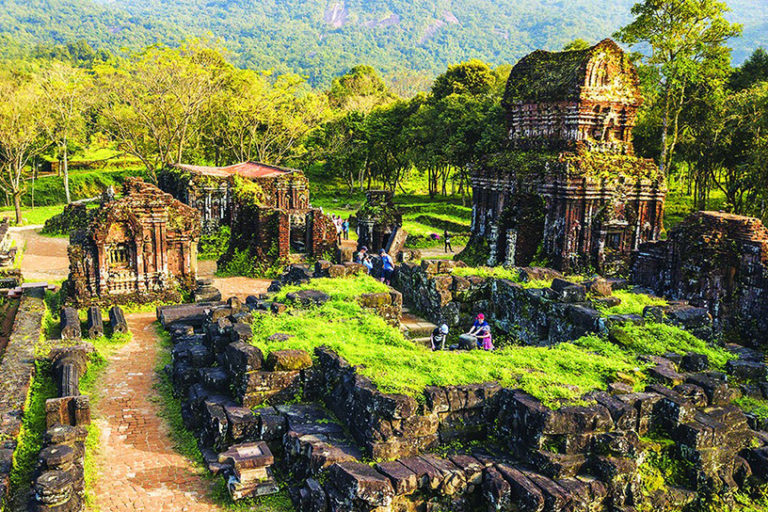24/7 Support: +84 903445750
Sapa, Vietnam: Top 10 Things To Do
Sapa is one of Vietnam’s top destinations, beloved by international tourists. Although it’s just a small town, Sapa offers a wealth of cultural, human, and natural beauty in the majestic mountains of Northern Vietnam. Let’s explore Sapa and the must-visit attractions when you come here.
Overview of Sapa Town
Located about 30 km from the center of Lao Cai city, Sapa is a small town perched at an average altitude of 1,500m – 1,800m above sea level. To reach Sapa, you’ll need to travel by car or motorbike, navigating numerous curves and hills amidst the tranquil and stunning scenery. Once you arrive in the heart of Sapa town, you’ll immediately sense a completely different atmosphere—bustling, crowded, and impressive are the first experiences that will greet you.

Sapa holds special qualities that are hard to find elsewhere, especially for international visitors. Beyond enjoying the fresh air and the simple peace of a North Western land, Sapa is also a place to admire the untouched beauty of terraced fields, waterfalls, and majestic mountains. You can also immerse yourself in the customs and cultural beauty of ethnic minority groups such as the Kinh, H’Mong, Giay, Dao Do, Tay, and Xa Pho.
Although these ethnic groups influence each other’s cultures, they still maintain their unique cultural identities and customs, passed down through generations. Annual festivals rooted in tradition include:
- The Roóng Pooc Festival of the Giay people
- The Jumping Tet Festival of the Dao Do people
- The Village Sweeping Festival of the Xa Pho people
- The Down the Field Festival in Ban Ho…
Traditional activities like love markets, weekend markets, and bamboo flute dancing are still preserved in their original forms.

Read more: Halong Bay: Information and Must-Do Activities
The Best Time to Visit Sapa
Many travelers wonder when the best time to visit Sapa is. In fact, you can visit Sapa at any time of the year, as each season offers a unique experience. However, we recommend visiting between September to December or January to April, which is considered the most beautiful time in Sapa. Although temperatures can sometimes drop to freezing, occasionally reaching 0°C with snowfall, the days are typically sunny, with average temperatures ranging from 15°C to 18°C. The fresh air and mild weather make it perfect for outdoor activities, especially trekking and admiring the golden rice fields.
The period from May to September marks the beginning of the rice planting season. The entire valley turns a lush green, resembling a painting amidst the majestic mountains. However, this is also the wettest season in Sapa, with early heavy rains often leading to landslides. Trekking during this time can be very dangerous.
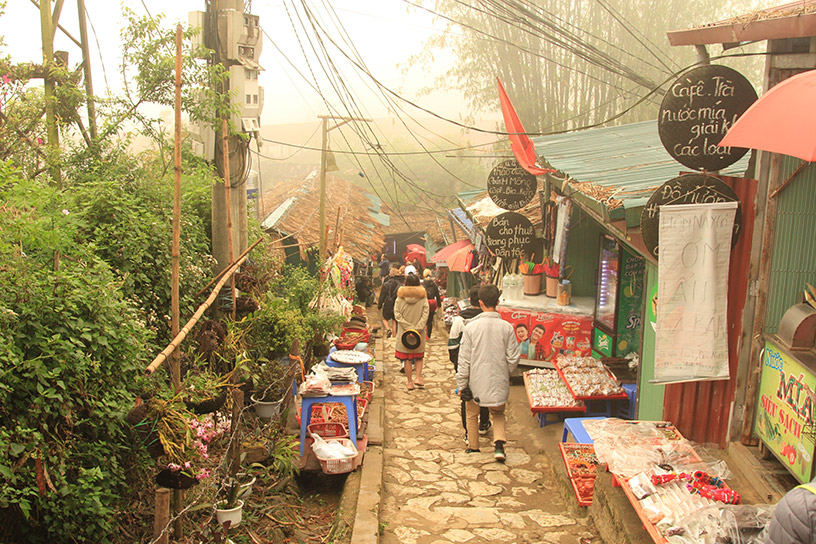
Top Tourist Attractions to Visit in Sapa
1. Sapa Stone Church – Sapa Love Market
A visit to Sapa wouldn’t be complete without stopping by the Sapa Stone Church, a striking architectural landmark built by the French in the early 20th century. It is the only French-built structure in Sapa that remains intact. Every detail of the church is steeped in Romanesque Gothic architecture, visible in the arched windows, stained glass, bell tower, and more.
Right next to the Stone Church is Sapa Square, where the famous Love Market takes place. Usually held from Saturday night until Sunday, if you visit on a weekend, you can witness young men and women from nearby villages such as Ta Phin, San Sa, Cat Cat, Lao Chai, and Ta Van gathering to meet, play leaf flutes, sing, throw a ball, tug of war, dance, and engage in other traditional activities at the Love Market.

2. Ham Rong Mountain, Sapa
Right behind the Stone Church is the Ham Rong Mountain tourist area. Conveniently located near the town, Ham Rong Mountain resembles a dragon’s shape and has an entrance fee of 70,000 VND per ticket. The mountain offers many scenic spots, including orchid gardens that capture the essence of the mountains and forests. From here, you can also enjoy a panoramic view of Sapa town nestled in the mist. It’s an easy walk to reach this spot, often referred to as the “Dalat Garden of the Northwest,” with its lush greenery and vibrant flowers.
Ham Rong Mountain is continuously being enhanced, with more greenery, flowers, and check-in spots for visitors. Standing on Ham Rong, you’ll feel as if the clouds are within your reach, the flowers in full bloom at your feet, and the sunlight gently warming the landscape. In the afternoon, you can watch a breathtaking sunset as it slowly descends behind the deep green mountain ranges.

3. Check-in at Sun Plaza Sapa Cable Car Station
Just a few steps from the Stone Church, you’ll find the Sun Plaza Sapa, where you can feel the “European vibe” in its architecture. Inspired by the Big Ben clock tower, the arched gateway and the antique yellowed walls evoke a nostalgic, old-world charm, accented by the warm teal color. This picturesque setting offers a stunning backdrop for photos, making you feel like you’re in Europe without leaving Vietnam.
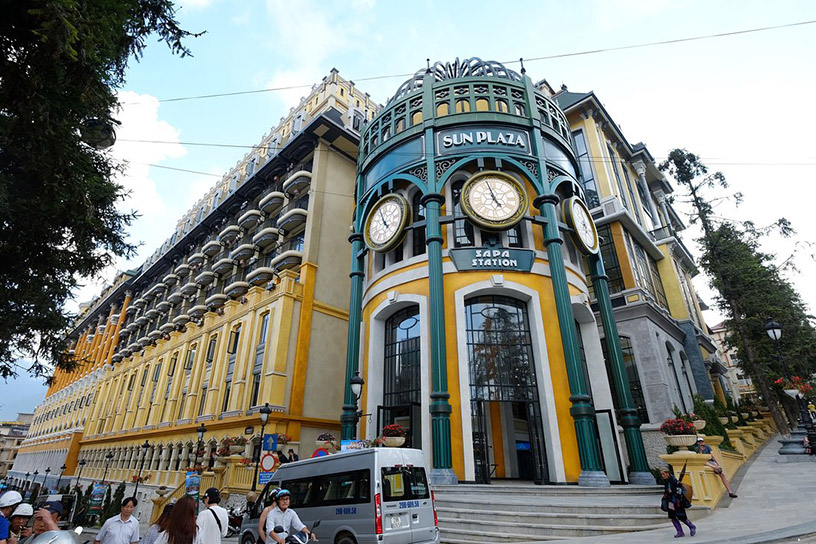
4. Muong Hoa Valley – Sapa Ancient Rock Field
Located 8 km southeast of Sapa town, Muong Hoa Valley is situated in Hau Thao Commune. Visiting Muong Hoa, you will encounter the ancient Sapa rock field, covered with mysterious carvings and symbols whose origins and meanings remain unknown to this day.
Now recognized as a national heritage site, the ancient rock field of Sapa is a unique legacy of the ancient Vietnamese people. Additionally, the beautiful 15 km long stream that winds through the villages of Lao Chai, Ta Van, Hau Thao, and Ban Ho is a rare natural wonder in Lao Cai.

5. Love Waterfall (Silver Waterfall)
Say goodbye to the “European charm” and artificial sites of Sapa, and immerse yourself in the authentic beauty of the Northwest with the vibrant green landscape bestowed by nature. This is Silver Waterfall, the tallest waterfall in the Northwest region.
Located about 12 km from Sapa town, Silver Waterfall boasts the wild, simple beauty of the mountains, with its water cascading down powerfully, spraying white mist like silver rain, hence the name. The waterfall descends from a height of 100 meters, creating foamy waves that merge into the stream below in the O Quy Ho Valley, producing a resonant, majestic sound.
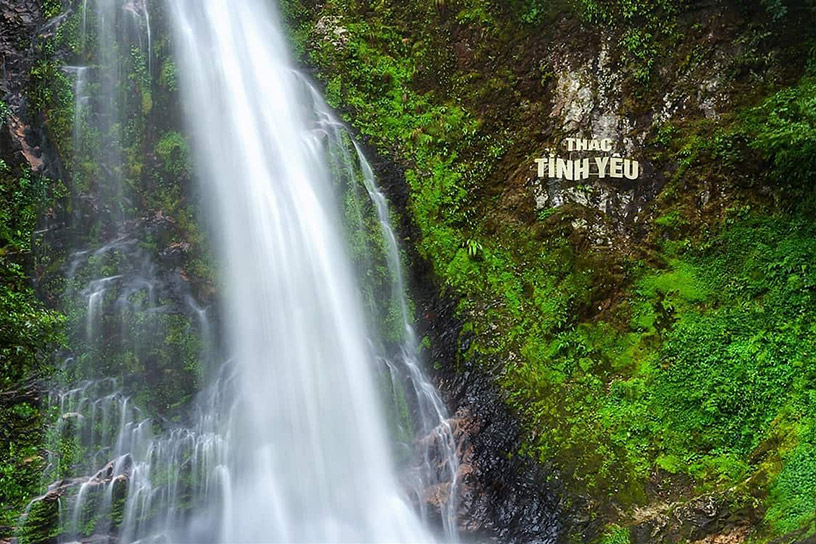
6. O Quy Ho Pass, Sapa
Known as one of the “Four Great Passes,” O Quy Ho Pass boasts breathtaking scenery that captivates visitors. Located on the road connecting Sapa town with Lai Chau province, the pass is flanked by lush green mountains. On clear days, visitors can enjoy a panoramic view of Fansipan Peak from the top of the pass.
This spot is also ideal for watching the sunset, as the twilight glow gently descends and fades into the thin mist, creating an incredibly beautiful and romantic scene for visitors.

7. Fansipan Peak – The Roof of Indochina
No matter the season, conquering Fansipan Peak, the Roof of Indochina, attracts both professional and amateur climbers. If you seek a challenge, you can opt for a trek that takes one to two days to reach the summit.
If your health or time constraints don’t allow for trekking, there’s another option: the Sun World Fansipan Legend cable car service. With ticket prices at 700,000 VND for adults and 500,000 VND for children, it takes only 15-20 minutes to glide over the golden rice fields of Muong Hoa Valley and take in the majestic Hoang Lien Son mountain range. At the legendary Fansipan summit, you’ll be immersed in the mystical white clouds and fog, resembling a heavenly scene.
Perched atop Fansipan is the Kim Son Bao Thang Pagoda, a temple shrouded in mist that exudes an air of mystery and sacredness. The pagoda’s architecture blends seamlessly with the natural contours of the mountain, rising and falling as if it were a natural part of the landscape. The most impressive feature of Kim Son Bao Thang Pagoda is the Great Buddha Statue of Amitabha, standing over 13 meters tall on a 6-meter-high lotus pedestal.
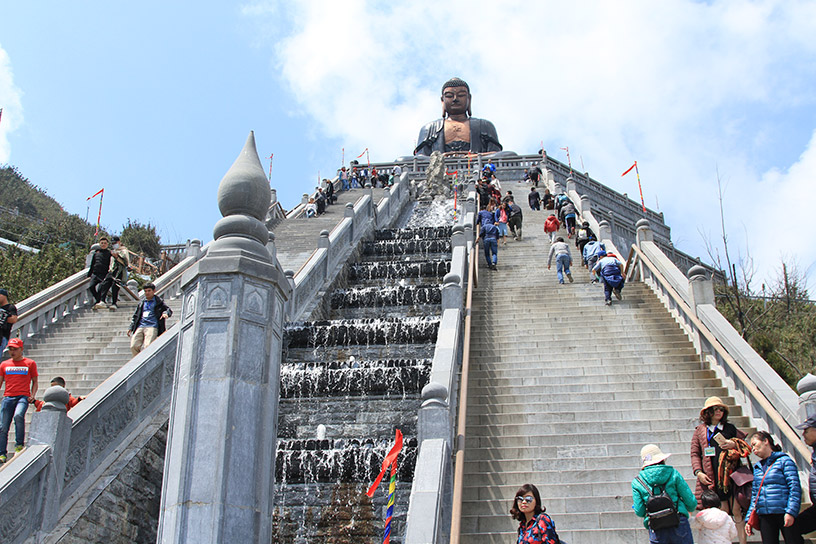
Unlike many other statues that are gilded or carved from stone, the Buddha statue here is assembled from thousands of bronze plates over a steel frame, designed to withstand deformation under extreme conditions. The dark gray color and massive size of the Amitabha Buddha at Kim Son Bao Thang radiate an aura of solemnity and sanctity, bringing peace to the hearts of pilgrims and visitors alike.


8. Bac Ha Market
Bac Ha Market is one of the largest markets in the highland border region, held every Sunday. Since the market operates only once a week, it always attracts a large number of villagers from near and far. If you travel to Sapa, visiting this famous tourist spot is a must!
For the ethnic people of Bac Ha, the market is not just a place for trading goods but also a social hub where they meet and enjoy each other’s company. Adults come to the market to trade, while children gather to play. The lively and bustling atmosphere is reminiscent of preparations for major festivals throughout the year.

9. Cat Cat Village
Sapa town is predominantly inhabited by the Hmong people, and if you want to gain a deeper understanding of their cultural beauty, Cat Cat Village is the ideal place to visit. Located about 2 km from Sapa town, you can easily reach Cat Cat Village by motorbike. To enter the village, you’ll need to purchase an entrance ticket for 70,000 VND per person.
Cat Cat Village is surrounded by mountains and forests, with a gentle, poetic stream flowing through the center. As you stroll through the village, you’ll come across Hmong women sitting and weaving fabric, embroidering, and sewing. You’ll have the opportunity to admire the stunning terraced rice fields and immerse yourself in vibrant flower fields, bringing a sense of peace as you lose yourself in the serene landscape.
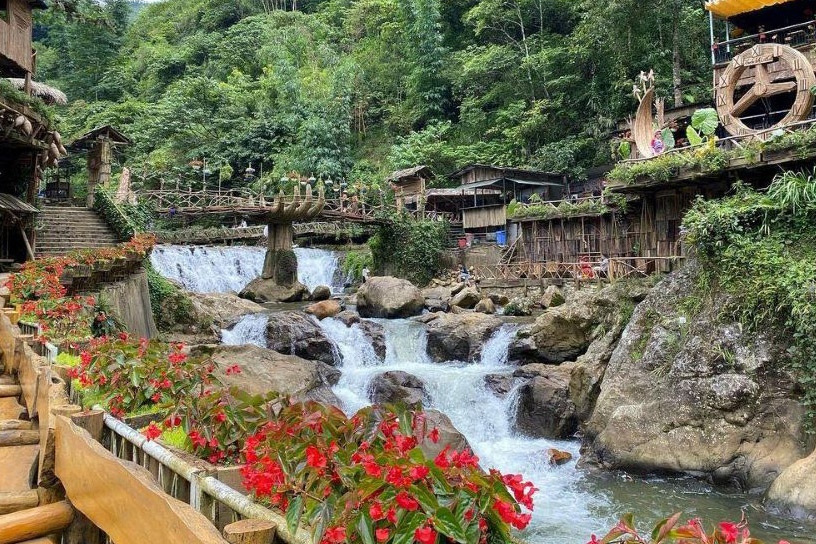
10. Ta Van Village
Ta Van Village is home to the Red Dao and Hmong people. The road from Sapa to Ta Van Village is a winding dirt path that rises and falls through the landscape. On either side of the road, you’ll see rice fields, scattered houses, forests, and small shops. Along the way, you might come across traditional clothing tailors and small stores selling embroidered souvenirs. Additionally, you may also spot meat hanging above fireplaces, a specialty food of the northern highlands.
As you venture deeper into Ta Van Village, you’ll encounter a different side of Sapa—one that is not as glamorous as the town center. This is the Sapa of the local people, with sunlit houses and children sitting around the fire with distant expressions on their faces.
Life here is quite lacking in resources. It’s common to see children with dirty faces and bare feet, selling small souvenirs. Ta Van Village reveals the culture, lifestyle, daily activities, and the real circumstances of the Hmong and Dao people living here.

How to Get to Sapa?
If you’re in Ho Chi Minh City or in the southern and central provinces of Vietnam, you will first need to take a flight or train to Hanoi, and then continue your journey to Sapa. If you’re already in Hanoi, here are the transportation options you can choose from:
Train
The train from Hanoi will take you to Lao Cai Station, which is about 30 km from Sapa town center. From there, you will need to purchase a bus ticket to continue your journey up to Sapa. Train ticket prices from Hanoi to Sapa range from 130,000 VND to 600,000 VND per person, with tourist train tickets being slightly more expensive at around 750,000 VND per person. Some well-rated train services include Orient Express, King Express, and Fansipan.
To purchase train tickets, you can book online (https://dsvn.vn) or buy them at the ticket counter at Hanoi Station. If you’re traveling during holidays, it’s recommended to book early to avoid tickets selling out!
Bus
Bus ticket prices from Hanoi to Sapa range from 250,000 VND to 350,000 VND per person, depending on the quality of the bus. Some reputable bus companies include Hung Thanh and Ha Son Hai Van.
You can usually purchase tickets at My Dinh Bus Station or the Southern Bus Station in Hanoi!
Read more: The Night Market in Hoi An
Things to Keep in Mind When Visiting Sapa
Considering the following tips will help make your trip to Sapa even more enjoyable.
- In Sapa, there are still instances where tourists are pressured to buy goods. If you don’t intend to purchase anything, it’s best not to browse, as vendors may follow you to persuade you to buy.
- Remember to bring a jacket, raincoat, or umbrella wherever you go in Sapa, as the weather can change suddenly, and it might rain at any time.
- If you rent a motorbike to explore, be sure to carry your identification, driver’s license, and always wear a helmet when driving.
- Although Sapa has many hotels and homestays, rooms can be fully booked during holidays or weekends. It’s wise to plan ahead and book your accommodations online in advance.
- Avoid taking photos with the local people without asking for their permission first. If you do take pictures with them, consider tipping them around 2 USD.
Conclusion
Sapa, with its diverse experiences, is a must-visit destination in Vietnam. Whether you are captivated by the tranquil beauty of Cat Cat Village, the rich culture of Ta Van Village, or the challenge of conquering Fansipan Peak, Sapa has something to meet all your needs. It would be more convenient if there were an airport here, but the scenic views of the mountains during a car ride are quite enjoyable. We hope this article helps you have an exciting and wonderful experience on your trip to Sapa.

